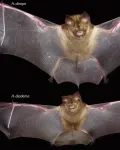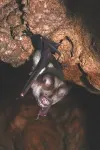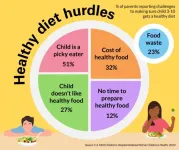(Press-News.org) A University of Melbourne researcher has spotted a rare evolutionary phenomenon happening rapidly in real time in bats living in the Solomon Islands.
Dr Tyrone Lavery reports in a paper published in Evolution that two groups of leaf-nosed bats with vastly different body sizes that were thought to be separate species are an example of a rare type of parallel evolution. Parallel evolution is when different populations living in similar environments evolve similar features independently.
The smaller bat, Hipposideros diadema, is found across its six main islands and many smaller islands. It is also common in South East Asia, Papua New Guinea and parts of northern Australia. The much larger bats were named in 1905 as H. dinops, or Fierce Leaf-Nosed Bat, and are found only in the Solomon Islands. The two sizes live together on most islands, which all have similar forested habitat.
“Although they are very different sizes, the bats’ DNA is very similar. They use very different sonar frequencies, they probably eat different food, and even when they live in the same cave together they don’t interbreed. That is why no one has ever really questioned whether they were different species,” Dr Lavery said.
Dr Lavery said despite their independent origins, each group of larger bats has evolved to look the same, averaging more than double the weight of the small bat. “Our research suggests the rapid and repeated evolution of larger bodied bats from smaller bats, each happening independently on separate islands,” he said.
“When we created family trees using the bats’ DNA, we found that what we thought was just one species of large bat in the Solomon Islands was actually a case where bigger bats had evolved from the smaller species multiple times across different islands,” he said.
This type of parallel evolution arising from separated populations of the same species has only been observed in action a few times before and is believed to be the first time it has been documented in real time in mammals.
Parallel evolution has been found in parts of the world when populations are geographically separated but live in similar environments – such as different islands or lakes. One common type of parallel evolution is convergent evolution. For example thylacines and wolves are two separate species with different origins that evolved separately to look similar. But Dr Lavery said it was rare to see two isolated populations of the same species go through the same evolutionary process.
“Something very strong is pushing or selecting for these big bats, and it is strong enough for it to happen multiple times on different islands. We think these larger bats might be evolving to take advantage of prey that the smaller bats aren’t eating. Although they could probably interbreed, they don’t for some reason,” he said.
Across the islands, the sonar frequencies of larger bats are lower and suited to hunting bigger prey, while the smaller bats use a higher frequency. This probably means the larger bats are eating larger insects, or even frogs, Dr Lavery said.
Measuring 103 bat specimens from the Australian Museum, Queensland Museum, University of Kansas Natural History Museum, and the Bernice Pauahi Bishop Museum in Hawaii, Dr Lavery also found no overlap in body size between the two groups – the smaller “species” was always easily identified from the larger bats.
“Over time larger body size may have been part of behavioural and physical adaptations needed to hunt larger prey. This might mean the bigger and smaller bats no longer recognise each other as mates, and so they live separate lives.”
Dr Lavery said this parallel evolution pattern in leaf-nosed bats had been observed in Solomon Islands on Guadalcanal and in the Western Province, and more research was needed to see if the same pattern was repeated on other islands.
“We may think of evolution as very slow process, but it can happen rapidly when the conditions are right and two groups are separated and stop interbreeding. They can begin to evolve on different pathways,” he said.
“Islands are famous for helping us to observe and understand the processes for how species evolve in real time. They’re also places that are very vulnerable to the types of disturbance created by humans create. It’s important that we look after these incredible landscapes in Solomon Islands before we lose these stories even before we find them.”
A University of Melbourne researcher has spotted a rare evolutionary phenomenon happening rapidly in real time in bats living in the Solomon Islands.
Dr Tyrone Lavery reports in a paper published in Evolution that two groups of leaf-nosed bats with vastly different body sizes that were thought to be separate species are an example of a rare type of parallel evolution. Parallel evolution is when different populations living in similar environments evolve similar features independently.
The smaller bat, Hipposideros diadema, is found across its six main islands and many smaller islands. It is also common in South East Asia, Papua New Guinea and parts of northern Australia. The much larger bats were named in 1905 as H. dinops, or Fierce Leaf-Nosed Bat, and are found only in the Solomon Islands. The two sizes live together on most islands, which all have similar forested habitat.
“Although they are very different sizes, the bats’ DNA is very similar. They use very different sonar frequencies, they probably eat different food, and even when they live in the same cave together they don’t interbreed. That is why no one has ever really questioned whether they were different species,” Dr Lavery said.
Dr Lavery said despite their independent origins, each group of larger bats has evolved to look the same, averaging more than double the weight of the small bat. “Our research suggests the rapid and repeated evolution of larger bodied bats from smaller bats, each happening independently on separate islands,” he said.
“When we created family trees using the bats’ DNA, we found that what we thought was just one species of large bat in the Solomon Islands was actually a case where bigger bats had evolved from the smaller species multiple times across different islands,” he said.
This type of parallel evolution arising from separated populations of the same species has only been observed in action a few times before and is believed to be the first time it has been documented in real time in mammals.
Parallel evolution has been found in parts of the world when populations are geographically separated but live in similar environments – such as different islands or lakes. One common type of parallel evolution is convergent evolution. For example thylacines and wolves are two separate species with different origins that evolved separately to look similar. But Dr Lavery said it was rare to see two isolated populations of the same species go through the same evolutionary process.
“Something very strong is pushing or selecting for these big bats, and it is strong enough for it to happen multiple times on different islands. We think these larger bats might be evolving to take advantage of prey that the smaller bats aren’t eating. Although they could probably interbreed, they don’t for some reason,” he said.
Across the islands, the sonar frequencies of larger bats are lower and suited to hunting bigger prey, while the smaller bats use a higher frequency. This probably means the larger bats are eating larger insects, or even frogs, Dr Lavery said.
Measuring 103 bat specimens from the Australian Museum, Queensland Museum, University of Kansas Natural History Museum, and the Bernice Pauahi Bishop Museum in Hawaii, Dr Lavery also found no overlap in body size between the two groups – the smaller “species” was always easily identified from the larger bats.
“Over time larger body size may have been part of behavioural and physical adaptations needed to hunt larger prey. This might mean the bigger and smaller bats no longer recognise each other as mates, and so they live separate lives.”
Dr Lavery said this parallel evolution pattern in leaf-nosed bats had been observed in Solomon Islands on Guadalcanal and in the Western Province, and more research was needed to see if the same pattern was repeated on other islands.
“We may think of evolution as very slow process, but it can happen rapidly when the conditions are right and two groups are separated and stop interbreeding. They can begin to evolve on different pathways,” he said.
“Islands are famous for helping us to observe and understand the processes for how species evolve in real time. They’re also places that are very vulnerable to the types of disturbance created by humans create. It’s important that we look after these incredible landscapes in Solomon Islands before we lose these stories even before we find them.”
END
Same species, different sizes: rare evolution in action spotted in island bats
2024-04-22
ELSE PRESS RELEASES FROM THIS DATE:
New technology uncovers mechanism affecting generation of new COVID variants
2024-04-22
The SARS-CoV-2 virus that causes COVID has the unsettling ability of often generating variants of itself. Other viruses also mutate, but as SARS-CoV-2 quickly spread throughout the entire human population during the pandemic, killing millions, the virus’ dynamic evolution posed a serious problem: it repeatedly challenged our bodies’ immune response fighting the virus and hindered the process of getting updated vaccines ready.
Understanding the genetic mechanism fueling SARS-CoV-2’s ability to generate variants can go a long way in keeping COVID at bay. In this study published in Nature Microbiology, researchers at Baylor College of Medicine and collaborating institutions developed ...
Planning at multiple scales for healthy corals and communities
2024-04-22
Governments in the Mesoamerican Reef region are exploring the use of nature-based solutions to strengthen coral health and societal benefits for coastal communities. A new study led by Stanford researchers in collaboration with scientists from the World Wildlife Fund, the Healthy Reefs Initiative, and others from the Smart Coasts project quantified the outcomes of different watershed interventions to support coral health at regional versus national scales, and identified target areas that could improve both ecosystem and societal benefits nationally and across the region.
The nature-based approaches evaluated as key ...
U of T researchers map protein network dynamics during cell division
2024-04-22
An international team led by researchers at the University of Toronto has mapped the movement of proteins encoded by the yeast genome throughout its cell cycle. This is the first time that all the proteins of an organism have been tracked across the cell cycle, which required a combination of deep learning and high-throughput microscopy.
The team applied two convolutional neural networks, or algorithms, called DeepLoc and CycleNet, to analyze images of millions of live yeast cells. The result was a comprehensive map identifying where proteins are located and how they move and change in abundance ...
Pressure in the womb may influence facial development
2024-04-22
Physical cues in the womb, and not just genetics, influence the normal development of neural crest cells, the embryonic stem cells that form facial features, finds a new study led by UCL researchers.
The study published in Nature Cell Biology found that an increase in hydrostatic pressure sensed by the embryo can hinder the healthy development of facial features in mouse and frog embryos and in human embryoids (cell structures grown in the lab from human stem cells), suggesting that differences in pressure might affect the risk of facial malformations.
The ...
AI weather forecasts captured Ciaran’s destructive path
2024-04-22
Artificial intelligence (AI) can quickly and accurately predict the path and intensity of major storms, a new study has demonstrated.
The research, based on an analysis of November 2023’s Storm Ciaran, suggests weather forecasts that use machine learning can produce predictions of similar accuracy to traditional forecasts faster, cheaper, and using less computational power.
Published in npj Climate and Atmospheric Science, the University of Reading study highlights the rapid progress and transformative potential of AI in weather prediction.
Professor Andrew Charlton-Perez, ...
Feedback loop that is melting ice shelves in West Antarctica revealed
2024-04-22
Feedback loop that is melting ice shelves in West Antarctica revealed
New research has uncovered a feedback loop that may be accelerating the melting of the floating portions of the West Antarctic Ice Sheet, pushing up global sea levels.
The study, published in Science Advances, sheds new light on the mechanisms driving the melting of ice shelves beneath the surface of the ocean, which have been unclear until now.
The West Antarctic Ice Sheet has been losing mass in recent decades, contributing to global sea level rise. If it were to melt entirely, global sea levels would rise by around five meters.
It’s known that Circumpolar Deep Water (CDW), ...
How does aspirin help prevent colorectal cancer development and progression?
2024-04-22
Long-term daily use of aspirin can help to prevent the development and progression of colorectal cancer, but the mechanisms involved have been unclear. New research has revealed that aspirin may exert these protective effects by boosting certain aspects of the body’s immune response against cancer cells. The findings are published by Wiley online in CANCER, a peer-reviewed journal of the American Cancer Society.
To investigate the effects of aspirin (a nonsteroidal anti-inflammatory drug) on colorectal cancer, investigators in Italy obtained tissue samples from 238 patients who underwent surgery for colorectal cancer in 2015–2019, 12% of whom were aspirin ...
3 in 5 parents play short order cook for young children who don’t like family meal
2024-04-22
While most parents of preschool and elementary aged children strive to give their children a balanced, nutritional diet, some of their strategies to promote healthy eating may backfire, a national poll suggests.
A top example from the report: Three in five parents customize meals if their child doesn’t like what everyone else is eating.
Meanwhile, one in eight parents require children to eat everything on their plate, according to the University of Michigan Health C.S. Mott Children’s Hospital National Poll on Children’s Health. And while just one in three believe the standard American diet is healthy for kids, few have tried alternative, potentially more nutritional ...
Japan’s premodern concept of nature at root of distinctive mindset in early childhood education
2024-04-22
Osaka, Japan — Observers of Japanese early childhood education and care have pointed to the mindset of educators watching over and waiting on preschoolers as being an intriguing tendency. This mimamoru approach has its roots in a premodern concept of nature, according to Professor Yosuke Hirota at the Graduate School of Literature and Human Sciences of Osaka Metropolitan University.
Professor Hirota looked into the works of Sozo Kurahashi (1882-1955) and Kitaro Nishida (1870-1945) to see how this concept of nature from the past made its way into education in the present day. Kurahashi’s writing on ...
First Nations patients leave ED without completing treatment more than comparable non–First Nations patients
2024-04-22
First Nations patients in Alberta leave emergency departments (EDs) without completing treatment more often than comparable non–First Nations patients, due in part to anti-Indigenous racism expressed by providers, found new research published in CMAJ (Canadian Medical Association Journal) https://www.cmaj.ca/lookup/doi/10.1503/cmaj.231019.
Higher proportions of incomplete ED care for First Nations patients compared with non–First Nations patients occurred even in cases of serious diagnosis, and were found across all parts of Alberta. Provincially, 6.8% of First Nations visits end without completing ...





